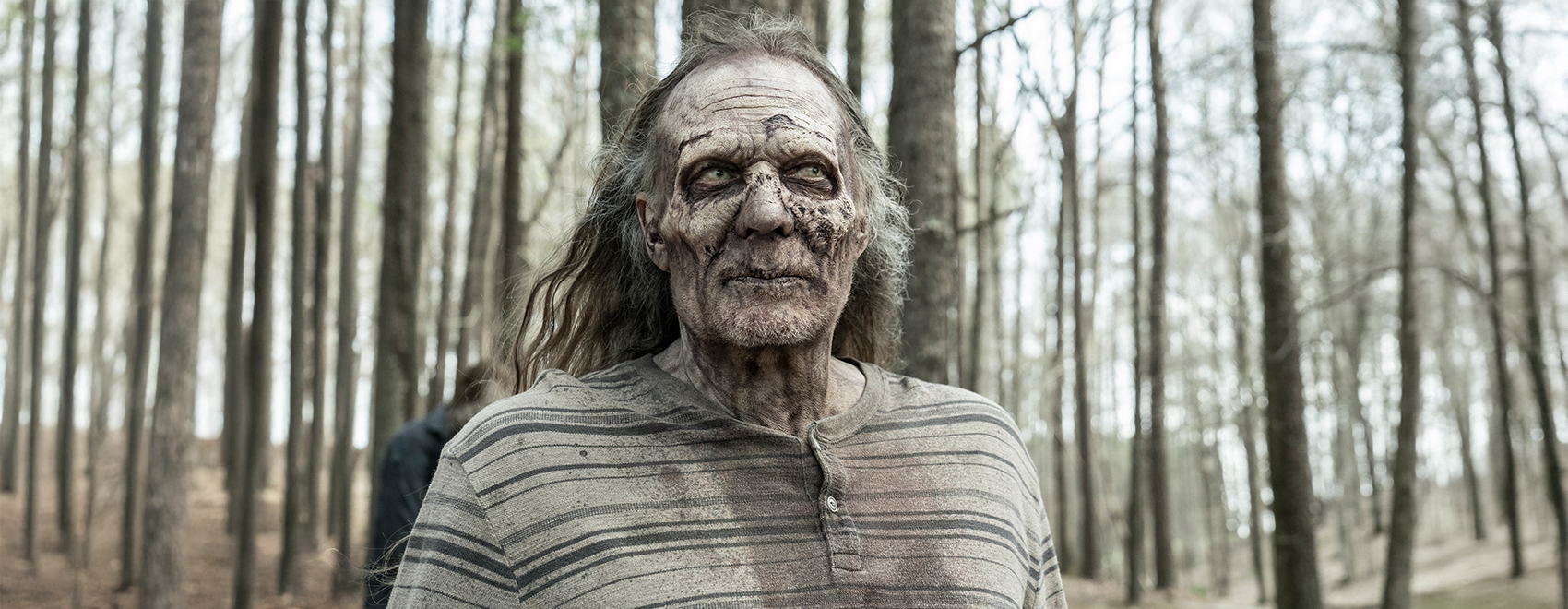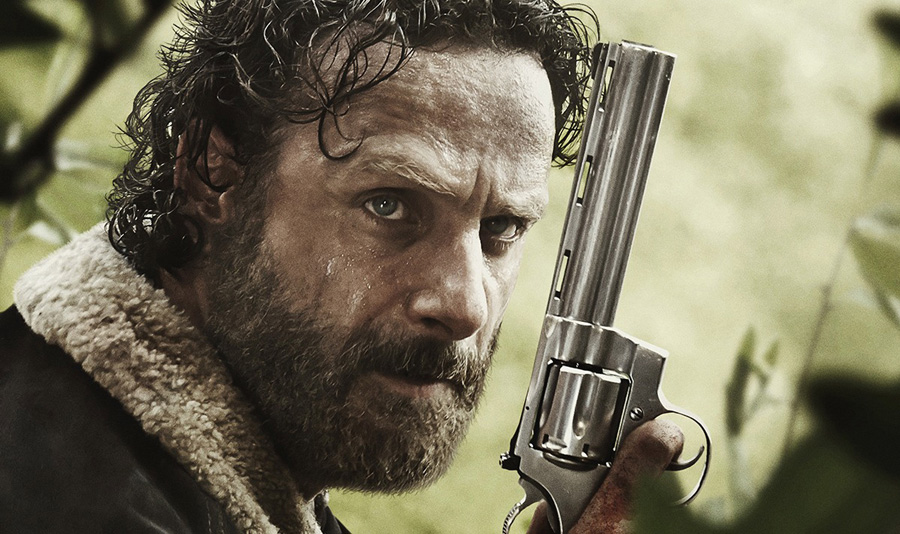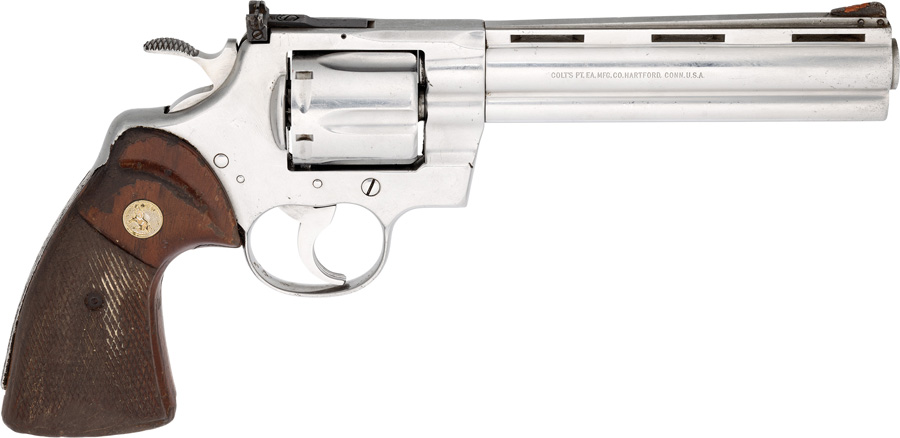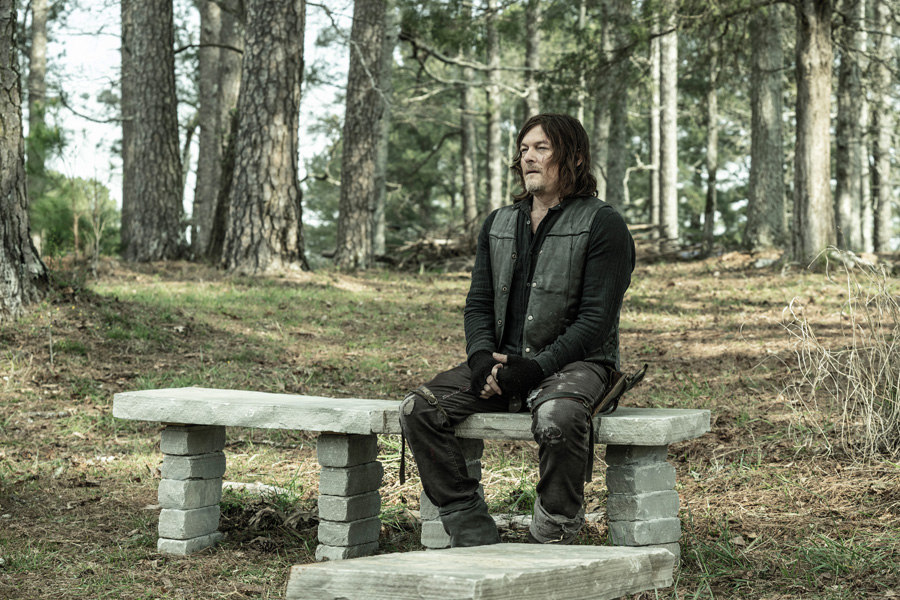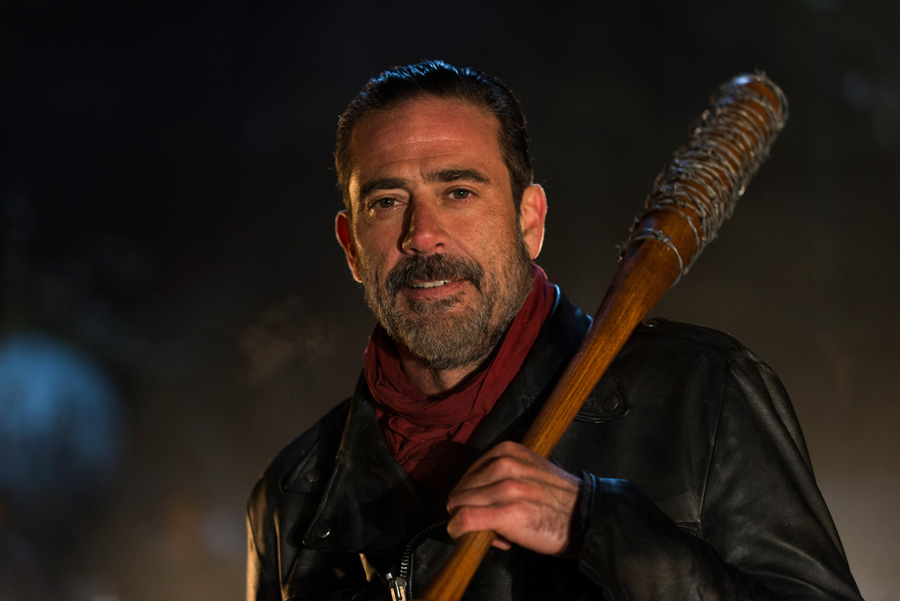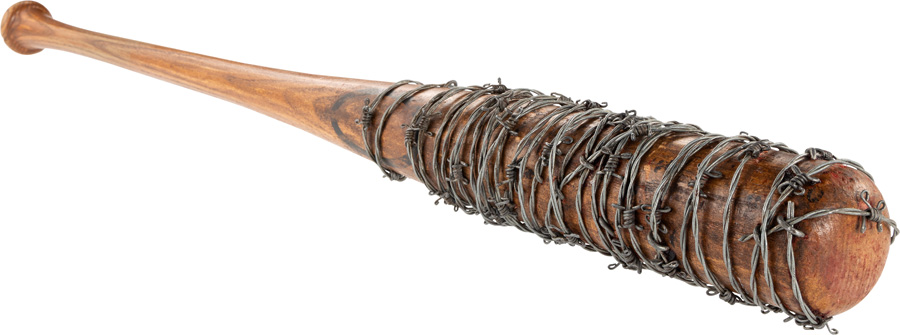THE SPECIAL EFFECTS LEGEND REFLECTS ON HIS MAGNUM OPUS AS MORE THAN 1,000 COSTUMES, WEAPONS, AND WALKER PROSTHETICS HIT THE AUCTION BLOCK
By Colin Tait | October 7, 2025
Greg Nicotero loves talking about blood. Whether you know his name or not, you certainly know his bloodstained work. From the brain-splattered backseat of Jules’ car in Pulp Fiction and the arterial spray in Kill Bill to the undead swarming in Day of the Dead and the gut-wrenching Walker attacks in The Walking Dead, you’ve seen it – and you’ve felt it. His scenes are among the most visceral, realistic, and unsettling in modern film and television, the kind that leave an imprint long after the credits roll. The showrunner, director, producer, and special effects legend has spent four decades perfecting the craft of making things bleed, rot, and terrify – always with one mantra in mind: “The blood is telling the story.”
That ethos will be on display for fans and collectors October 30-November 1, when Heritage Auctions offers more than 1,000 items from The Walking Dead – from Rick’s signature Colt Python revolver and Michonne’s katana to Daryl’s leather vest and Negan’s bloodletting bat, Lucille.
Enlarge
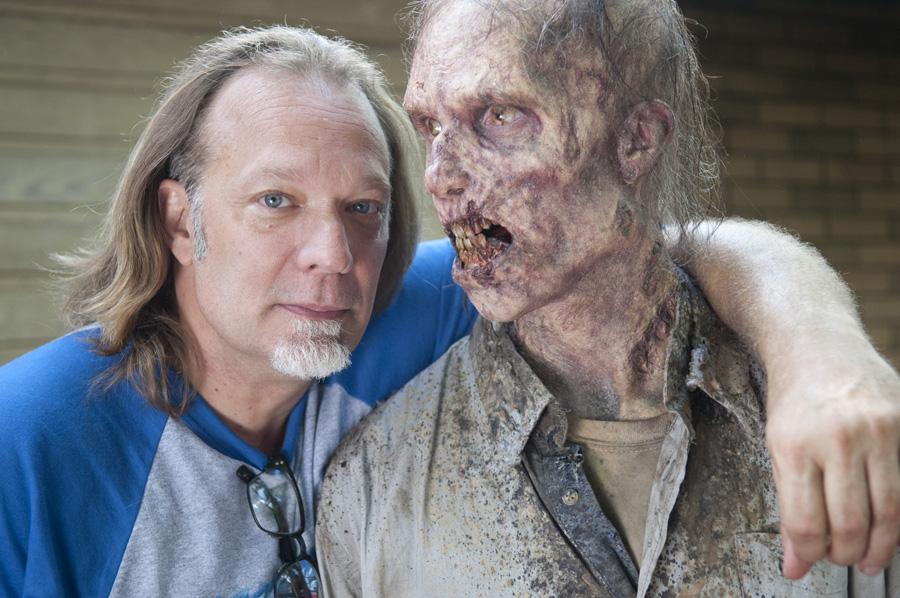
Nicotero with one of his hyperrealistic Walker creations (Photo courtesy AMC Networks)
Enlarge
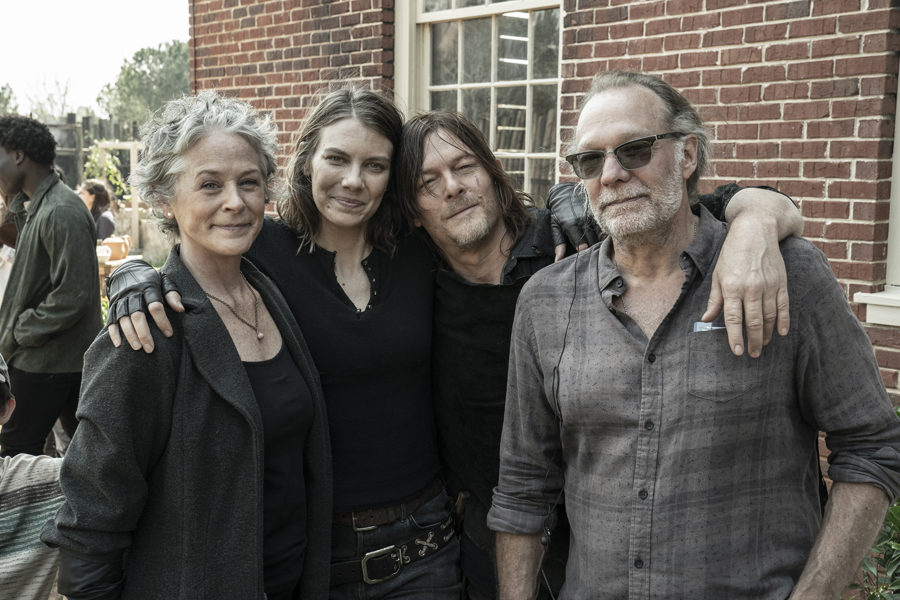
From left: Cast members Melissa McBride, Lauren Cohan, and Norman Reedus with Nicotero on the Georgia set of ‘The Walking Dead’ (Photo courtesy AMC Networks)
Learning From the Best
Nicotero came of age in what he calls the “last great era of practical effects” – a time before digital technology dominated, when gore, monsters, and creatures were created with latex, animatronics, and gallons of fake blood. He learned directly from the masters: George A. Romero, the godfather of the zombie genre, and Tom Savini, the groundbreaking makeup and effects artist behind Dawn of the Dead and Friday the 13th. “I was lucky,” he says. “I learned from the best at the exact moment in history when the field was at its most innovative.”
He’s one of the rare industry figures whose résumé reads like a guided tour through both the blood-spattered history of horror and the upper echelons of contemporary cinema. His bloody fingerprints are all over cult classics like Day of the Dead, Evil Dead II, Jason Goes to Hell, Predator, and Army of Darkness – the kind of titles that helped define entire subgenres and earned him a place alongside legends like Romero and Savini.
But Nicotero’s work doesn’t stop at the graveyard gates. He has also had a hand in mainstream and prestige projects such as The Green Mile, The Chronicles of Narnia, and Once Upon a Time in Hollywood, as well as Pulp Fiction, Scream, Spawn, Boogie Nights, and Mulholland Drive. Along the way, he has collaborated with a who’s who of cinema’s most distinctive voices – Quentin Tarantino, Paul Thomas Anderson, David Lynch, Robert Rodriguez – building a body of work that effortlessly straddles the line between genre-defining horror and art-house prestige. It’s the kind of career that would impress even the most hard-to-please horror purists, while earning nods of respect from Hollywood’s most exacting auteurs.
Andrew Lincoln played Sheriff Rick Grimes in the first nine seasons of ‘The Walking Dead.’ Throughout that time, this .357 Colt Python revolver rarely left his side.
The Walking Dead: The Magnum Opus
For all those credits, Nicotero’s magnum opus is The Walking Dead, a sprawling, 15-year (and counting) epic in which viewers follow everyday people navigating their way through a zombie apocalypse. His involvement was crucial from the very beginning. In the pilot episode, it was Nicotero and his company KNB EFX Group who brought to life Bicycle Girl and Teddy Bear Girl, the first Walkers that hero Rick Grimes encounters.
From that first sequence, KNB’s work set the tone. The Walkers had to be realistic enough to disturb, detailed enough to be authentic, and consistent enough to give actors a fully immersive universe to work within. That visceral, lived-in world became the show’s hallmark. Now, the very costumes, prosthetics, and props from those moments are part of Heritage’s October 30-November 1 The Walking Dead Universe Hollywood/Entertainment Signature® Auction.
Heritage’s October 30-November 1 The Walking Dead Universe Hollywood/Entertainment Signature® Auction includes a variety of Walker ensembles. Created by KNB EFX Group under Nicotero’s supervision, these ensembles were designed for the series’ background performers.
The TV Show That Made Horror Mainstream
When The Walking Dead premiered in 2010, AMC was riding high on the critical success of Mad Men and Breaking Bad. But the zombie drama broke new ground, becoming the most-watched cable series in history. Its Season 5 premiere drew 17.3 million live viewers, outpacing NFL games in key demographics and redefining what television horror could be. “We just wanted to make a great show,” Nicotero says. “[Executive producer] Frank Darabont and I were committed to the legacy of George [A. Romero] and Night of the Living Dead. The Walking Dead was basically an homage to that universe George created. It wasn’t about zombies; it was about people, survival, and human dynamics.”
The show’s enduring power, he believes, comes from the constant undercurrent of uncertainty. “There was always someone for you to root for – and always the dread that your favorite might be the next victim of some horrible demise,” he says. That unpredictability is the logic of horror and the essence of suspense: It keeps you watching, even as you brace for the worst. That same emotional weight is embedded in the objects heading to auction – not just Rick’s revolver or Michonne’s blades, but everyday items like weathered survivor costumes, each stitched and aged to carry their own quiet histories.
Norman Reedus, who plays fan favorite Daryl Dixon in ‘The Walking Dead’ franchise, donned this signature ensemble during the Season 11 series finale.
Building an Authentic Apocalypse
Nicotero’s pre-med background brought anatomical authenticity to the Walkers, making them as unnerving as they were believable. “Makeup is an additive process,” he says. “We altered anatomy – dentures that made lips look rotted away, lace wigs with hand-tied hair so it looked like it was falling out. My training in anatomy and physiology made a big difference.” That commitment to realism was so effective that it drew praise from professionals whose opinions truly mattered in that arena. “I’ve had forensic pathologists tell me our zombies look like real autopsies,” Nicotero says. “That’s the greatest compliment I could get.”
That same commitment extended to the living characters. Daryl Dixon’s costumes – several of which are in the October 30-November 1 auction – tell a story without dialogue: mismatched laces, patched pants, and sun-faded fabrics suggesting years of scavenging and survival. “We differentiated characters who had access to resources from those living out in the wild,” Nicotero says. “It tells you who they are without saying a word.”
Lucille, the barbed wire-wrapped baseball bat famously wielded by Jeffrey Dean Morgan’s Negan, made its first appearance in the final episode of Season 6 of ‘The Walking Dead.’

